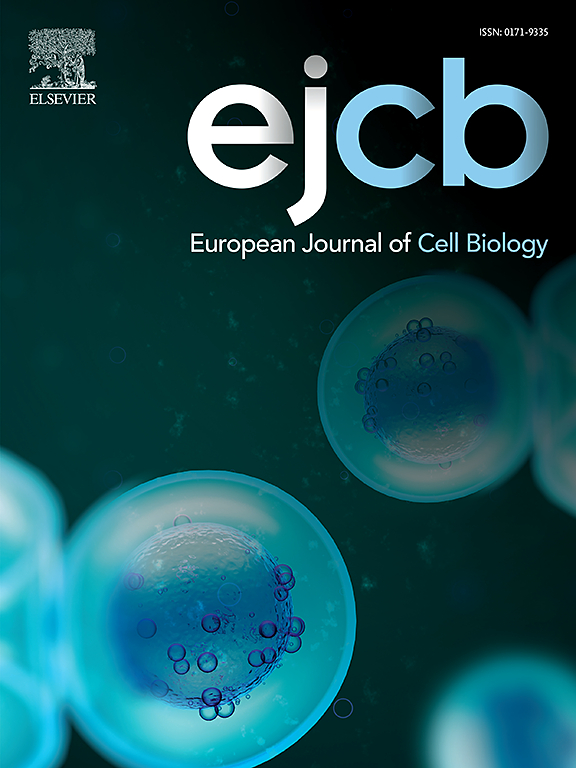Advances in modeling the Charcot-Marie-Tooth disease: Human induced pluripotent stem cell-derived Schwann cells harboring SH3TC2 variants
IF 4.3
3区 生物学
Q2 CELL BIOLOGY
引用次数: 0
Abstract
Human induced pluripotent stem cells (hiPSCs) represent a powerful tool for investigating neuropathological disorders, such as Charcot-Marie-Tooth disease (CMT), the most prevalent inherited peripheral neuropathy, where the cells of interest are hardly accessible. Advancing the development of appropriate cellular models is crucial for studying the disease’s pathophysiology. In this study, we present the first two isogenic hiPSC-derived Schwann cell models for studying CMT4C, also known as AR-CMTde-SH3TC2. This subtype of CMT is associated with alterations in SH3TC2 and is the most prevalent form of autosomal recessive demyelinating CMT. We aimed to study the impact of two nonsense mutations in SH3TC2. To achieve this, we used two CRISPR hiPSC clones, one carrying a homozygous nonsense mutation: c.211C>T, p.Gln71*, and the other one, carrying the most common AR-CMTde-SH3TC2 alteration, c.2860G>A, p.Arg954*. To study the endogenous expression of SH3TC2 in the cells mainly altered in AR-CMTde-SH3TC2, we initiated the differentiation of both our CMT clones and their isogenic control into Schwann cells (SCs). This study represents the first in vitro investigation of human endogenous SH3TC2 expression in AR-CMTde-SH3TC2 hiPSC-derived SC models, allowing for the examination of its expression and of its cellular impact. By comparing this AR-CMTde-SH3TC2 models to the control one, we observed disparities in RNA and protein expression of SH3TC2. Additionally, our RNA and coculture experiments with hiPSC-derived motor neurons (MNs) revealed delayed maturation of SCs and a reduced ability of SH3TC2-deficient SCs to sustain motor neuron culture. Our findings also demonstrated a disability in receptor recycling in SH3TC2-deficient cells, depending on the AR-CMTde-SH3TC2 alteration. These hiPSC-derived-SC models further provide a new modelling tool for studying Schwann cell contribution to CMT4C.
Charcot-Marie-Tooth病建模的进展:人类诱导的多能干细胞衍生的雪旺细胞含有SH3TC2变体
人类诱导多能干细胞(hipsc)是研究神经病理疾病的有力工具,例如最普遍的遗传性周围神经病变Charcot-Marie-Tooth病(CMT),其中感兴趣的细胞很难获得。推进适当的细胞模型的发展对研究该疾病的病理生理至关重要。在这项研究中,我们提出了头两个等基因hipsc衍生的雪旺细胞模型,用于研究CMT4C,也称为AR-CMTde-SH3TC2。这种CMT亚型与SH3TC2的改变有关,是常染色体隐性脱髓鞘性CMT最常见的形式。我们的目的是研究SH3TC2中两个无义突变的影响。为了实现这一点,我们使用了两个CRISPR hiPSC克隆,一个携带纯合无义突变:c.211C>;T, p.Gln71*,另一个携带最常见的AR-CMTde-SH3TC2突变,c.2860G> a, p.Arg954*。为了研究AR-CMTde-SH3TC2主要改变的细胞中SH3TC2的内源性表达,我们启动了将CMT克隆及其等基因对照分化为雪旺细胞(SCs)。本研究首次在体外研究AR-CMTde-SH3TC2 hipsc衍生的SC模型中人类内源性SH3TC2表达,从而检测其表达及其细胞影响。通过将AR-CMTde-SH3TC2模型与对照模型进行比较,我们观察到SH3TC2在RNA和蛋白表达上的差异。此外,我们的RNA和hipsc衍生的运动神经元(MNs)共培养实验显示,sc的成熟延迟,sh3tc2缺陷SCs维持运动神经元培养的能力降低。我们的研究结果还表明,在sh3tc2缺陷细胞中,受体循环障碍取决于AR-CMTde-SH3TC2的改变。这些hipsc衍生的sc模型进一步为研究雪旺细胞对CMT4C的贡献提供了新的建模工具。
本文章由计算机程序翻译,如有差异,请以英文原文为准。
求助全文
约1分钟内获得全文
求助全文
来源期刊

European journal of cell biology
生物-细胞生物学
CiteScore
7.30
自引率
1.50%
发文量
80
审稿时长
38 days
期刊介绍:
The European Journal of Cell Biology, a journal of experimental cell investigation, publishes reviews, original articles and short communications on the structure, function and macromolecular organization of cells and cell components. Contributions focusing on cellular dynamics, motility and differentiation, particularly if related to cellular biochemistry, molecular biology, immunology, neurobiology, and developmental biology are encouraged. Manuscripts describing significant technical advances are also welcome. In addition, papers dealing with biomedical issues of general interest to cell biologists will be published. Contributions addressing cell biological problems in prokaryotes and plants are also welcome.
 求助内容:
求助内容: 应助结果提醒方式:
应助结果提醒方式:


